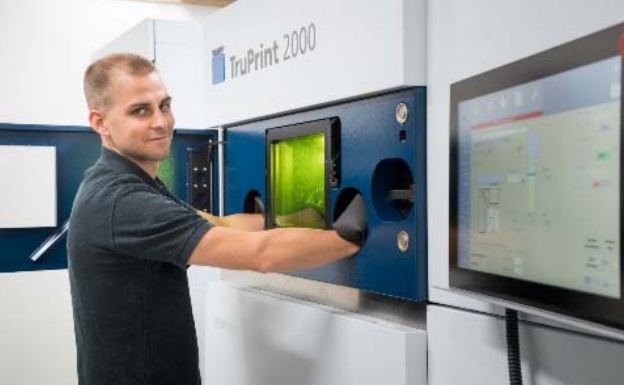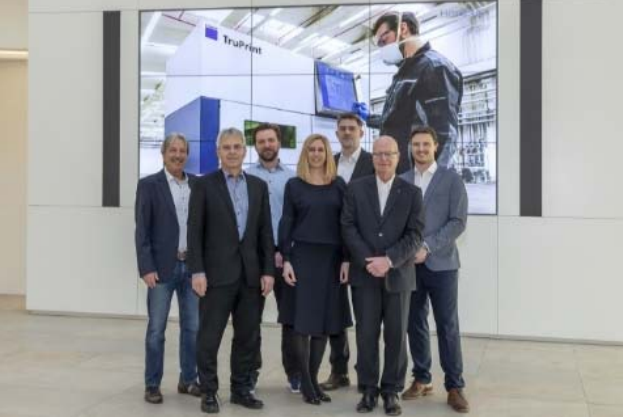Two German companies are collaborating to begin 3D printing industrial amorphous metals—also known as metallic glass and twice as strong as steel—offering greater elasticity and the potential to produce lightweight products. Heraeus AMLOY brings expertise in the production and processing of amorphous metals while TRUMPF introduces powerful experience in additive manufacturing.
The overall goal in this partnership is to see amorphous parts take their place in standard production, as well as enjoying the many benefits offered by 3D printing, mainly in affordability and better performance in production. Another added bonus is that 3D printing offers engineers much greater latitude during 3D design and printing, not only meaning that they are able to work on-demand for parts but they can also create and make changes to prototypes or components quickly without a middleman.
Amorphous parts display isotropic behavior, evident in materials like glass or metal—meaning that properties are the same in every direction. Applications like aerospace and mechanical engineering will benefit especially with the use of amorphous metals in production, as well as the medical field due to biocompatibility.
“Amorphous metals hold potential for numerous industries. For example, they can be used in medical devices – one of the most important industries for additive manufacturing. That is why we believe this collaboration is such a great opportunity to make even more inroads into this key market with our industrial 3D printing systems,” says Klaus Parey, managing director TRUMPF Additive Manufacturing.

TruPrint 2000 – The new TruPrint 2000 3D printer from TRUMPF is the ideal choice for printing amorphous metals from Heraeus AMLOY. (Source: TRUMPF)
3D printing also leads to the potential for new applications with amorphous metals:
“3D printing of amorphous components in industry is still in its infancy. This new collaboration will help us speed up printing processes and improve surface quality, ultimately cutting costs for customers. This will make the technology more suitable for a wider range of applications, some of which will be completely new,” says Jürgen Wachter, head of the Heraeus AMLOY business unit.
It is easy to understand why the two companies see the benefit of using a 3D printer for amorphous metals as they are created via molten metal that cools rapidly. Fabrication can be performed on a large scale and at a lighter weight, reducing the use of materials and eliminating extra waste. Parts can also be created in one piece rather than numerous parts that must be assembled afterward.
Heraeus AMLOY is currently optimizing their amorphous alloys for use with TRUMPF’s TruPrint systems, especially the latest-generation TruPrint 2000 machine.
“Two 300-watt lasers scan the machine’s entire build chamber in parallel. Using a laser focal diameter of just 55 micrometers, users can carry out both low and high-volume production of amorphous parts with extremely high surface quality. The ‘Melt Pool Monitoring’ function automatically monitors the quality of the melt pool, so any errors in the process are spotted at an early stage,” state the companies in a press release sent to 3DPrint.com.
Customers already working with TRUMPF 3D printers can use them for processing of Heraeus AMLOY zirconium-based alloys. Together, the two companies hope to make copper and titanium alloys available to customers for 3D printing soon.
Metal 3D printing is being used around the world today in a variety of industries, to include aerospace, automotive, medical, and more. What do you think of this news? Let us know your thoughts! Join the discussion of this and other 3D printing topics at 3DPrintBoard.com.

From left to right: The project team from Heraeus AMLOY and TRUMPF Additive Manufacturing: Hans-Jürgen Wachter (Head of Business Unit Heraeus AMLOY), André Kobelt (Chief Commercial and Technology Officer of Heraeus Holding), Moritz Stolpe (Heraeus AMLOY), Valeska Melde (Heraeus AMLOY), Arwed Kilian (TRUMPF Additive Manufacturing), Klaus Parey (Managing Director TRUMPF Additive Manufacturing), JanChristian Schauer (TRUMPF Additive Manufacturing). (Source: Heraeus AMLOY)
Subscribe to Our Email Newsletter
Stay up-to-date on all the latest news from the 3D printing industry and receive information and offers from third party vendors.
You May Also Like
Further Understanding of 3D Printing Design at ADDITIV Design World
ADDITIV is back once again! This time, the virtual platform for additive manufacturing will be holding the first-ever edition of ADDITIV Design World on May 23rd from 9:00 AM –...
3D Printer Maker EVO-tech Reborn as NEVO3D — Once More With Feeling
EVO-tech was a 3D printing service and original equipment manufacturer established in 2013 and based in Schörfling am Attersee, Austria. The company produced high-quality material extrusion systems featuring linear bearings,...
3D Systems Brings 3D Printed PEEK Cranial Implant to the U.S. with FDA Clearance
For more than 10 years, 3D Systems (NYSE:DDD) has worked hand-in-hand with surgeons to plan over 150,000 patient-specific cases, and develop more than two million instruments and implants from its...
CDFAM Returns to Berlin for Second Annual Symposium
The second CDFAM Computational Design Symposium is scheduled for May 7-8, 2024, in Berlin, and will convene leading experts in computational design across all scales. Building upon the first event...
































